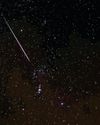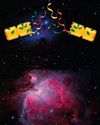Prøve GULL - Gratis
Get to know lunar rays
BBC Sky at Night Magazine
|October 2025
A full Moon might bleach the sky and thwart your stargazing, but it's the best time to catch the magnificent lunar rays
-
The worst time to look at the Moon is when it's full, right? Not necessarily. It's true that at full Moon, sunlight hits the surface head-on, flattening the appearance of its rugged landscape of deep craters, towering mountains and meandering valleys, showing only a flat, grey-and-white disc. But this direct lighting reveals something else: lunar rays - bright lanes of shattered rock and fine dust that fan out from impact craters.
While these are hard to see when the Sun is low in the lunar sky (when we see the Moon as a crescent or a gibbous disc), when the Sun's light strikes them from above during full Moon they shine. And with 2025's first supermoon coming on 7 October, there's never been a better time to see them.
Imagine you're standing on the Moon, 100 million years ago, watching a huge asteroid fall from the sky. As it hits, it blasts a crater – maybe 85km (53 miles) wide and 5km (3 miles) deep – out of the surface. It also sprays vast amounts of pulverised rock and dust away from the impact site, which arcs overhead. Where it settles, it leaves long rays of debris stretching back to the crater. That's how lunar rays were formed.
 Catch some rays! Seven to spot
Catch some rays! Seven to spot Find these craters for some lunar-ray-gazing fun during October's supermoon
Denne historien er fra October 2025-utgaven av BBC Sky at Night Magazine.
Abonner på Magzter GOLD for å få tilgang til tusenvis av kuraterte premiumhistorier og over 9000 magasiner og aviser.
Allerede abonnent? Logg på
FLERE HISTORIER FRA BBC Sky at Night Magazine

BBC Sky at Night Magazine
How to photograph the Geminids
Dramatic meteor photos aren't just down to luck. We show you how to bag one
3 mins
December 2025

BBC Sky at Night Magazine
10 Christmas crackers for your new telescope
So Santa brought you a telescope - what now? Stuart Atkinson sprinkles some cosmic sparkle, with 10 sights to see over one fabulous festive night - from glorious galaxies and planets to glittering star clusters
7 mins
December 2025

BBC Sky at Night Magazine
10 years of reusable rockets
Ben Evans charts the rise of multi-flight spacecraft, the tech revolution that's transforming our access to space
6 mins
December 2025

BBC Sky at Night Magazine
SKILLS FOR STARGAZERS
Take great photos of the Milky Way
3 mins
December 2025

BBC Sky at Night Magazine
Smart scopes: from backyard to big science
Home-based stargazers are helping scientists crack some of the Universe's big mysteries - and you can join them. Charlotte Daniels shows us how
6 mins
December 2025

BBC Sky at Night Magazine
FIELD OF VIEW
Forget Instagram – embrace the moment
2 mins
December 2025

BBC Sky at Night Magazine
Q&A WITH A PLANETARY LIFE EXPERT
Saturn's icy moon Enceladus boasts water, heat and organics. Now scientists have discovered it has complex chemistry too. Could it prove to be habitable?
3 mins
December 2025

BBC Sky at Night Magazine
INSIDE THE SKY AT NIGHT
When The Sky at Night joined Curious Cases for a special episode, George Dransfield was there to answer your burning questions. Here she dives deeper into her favourite
3 mins
December 2025

BBC Sky at Night Magazine
Students fix JWST's blurry vision
PhD researchers restore the telescope's ultra-precise imaging - without a spacewalk
1 min
December 2025

BBC Sky at Night Magazine
On a Mission
This is an inspiring tribute to the trailblazing women who shaped NASA's human spaceflight programmes.
1 mins
December 2025
Listen
Translate
Change font size

